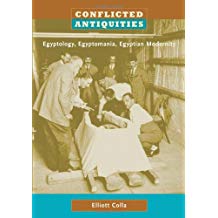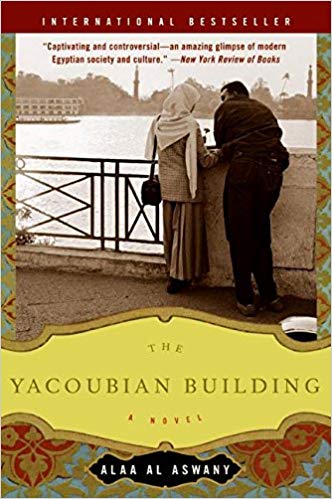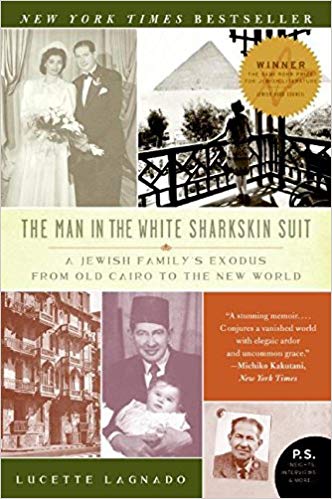Wonders are all around us – as are grievous ills – harms – and losses. It’s hard to figure out even my small corner of the world and how to be a good person in it.
Reading helps. Also talking to friends. I’m delighted for Sara Bhatia to return to Bacon today and share some of the things she saw and read and thought about on a recent trip to Egypt.
From Sara:
My family traveled to Egypt over winter break – a chance to see a few wonders of the world, explore ancient ruins, visit the sprawling capital city, soak in some winter sunshine, and dive in the Red Sea.
Cairo was so much more traditional than I had expected – nearly all the women wore a hijab with very modest, traditional dress, and many men wore a galabiya, a loose-fitting ankle-length robe.

The call to prayer echoes through the city, and our cosmopolitan guide – fluent in four languages and with a degree in English literature – periodically excused himself to find a nearby mosque to pray.

In old Islamic Cairo, there were mosques on every block – many have beautiful stone carvings, tiles, and ironwork which reminded me of Morocco and southern Spain
Surrounded by traditional Muslim culture, I was startled by the frank sexuality and the candid critique of the political and cultural life of contemporary Cairo in Alaa Al Alswany’s The Yacoubian Building. Indeed, the novel’s publication a dozen years ago scandalized Egypt before becoming an international bestseller.
The Yacoubian Building peeks inside a once grand art deco building in downtown Cairo, offering a glimpse at the lives of its varied inhabitants. The building’s residents range from a prosperous businessman with a flourishing storefront to poor migrants who inhabit the tiny airless closets on the rooftop, originally built as storage rooms for the building’s elites in the 1930s. The novel follows a dozen residents with intertwining fictional arcs. There’s Busayna, the sole breadwinner for her widowed mother and younger siblings, who endures repeated sexual abuse from her supervisor in a clothing store in return for pocket change. Busayna’s childhood sweetheart, Taha, dreams of joining the police academy and is rejected when he is unable to offer an adequate bribe to the police examiner, and in his disappointment, gets swept up in a jihad. Zaki Bey el Dessouki is an aging playboy who spends his days planning seductions of young women and reminiscing about his dissolute youth in Paris. Hagg Azzam, a wealthy businessman with political ambitions, becomes beholden to a local mob boss in exchange for fixing a local election. And there’s Hatim, the editor of a French language newspaper and the son of aristocrats, who inhabits a secret life in the illicit gay bars of Cairo. Individually, each story offers an engrossing look at a life behind the shuttered windows; collectively, The Yacoubian Building is a scathing attack on religious fervor, greed, the class system, corruption, and sexual immorality in contemporary Egypt.
* * * *
Lucette Lagnano’s lyrical memoir The Man in the White Sharkskin Suit begins like a prequel to The Yacoubian Building, harkening back to the heady days of World War II Cairo, when the city teemed with British soldiers along with French and American expats. This Cairo – the self-styled “Paris on the Nile” – sparkled with chic Egyptians mingling with Europeans at cafes and at nightclubs, where liquor flowed and couples danced until sunrise. Lagnano’s father – the titular man in the white sharkskin suit – was a “boulevardier,” a womanizer and gambler who played poker with the handsome young King Farouk. Lagnano’s father was also the son of Syrian Jewish refugees, and the family was part of Cairo’s large and dynamic Jewish community, nestled comfortably among Muslim neighbors and European expats.
I was drawn to this memoir for its depiction of a long lost, cosmopolitan Cairo – today there are small pockets of affluence in the capital city, including elegant hotels and shopping malls with Western luxury goods, but it was unclear to me whether they catered to Egyptian elites or tourists. Today’s city is chaotic and crowded and tired and dilapidated. There’s a film of dust and dirt covering everything – it is hard to imagine the shimmering city of Lagnano’s youth. The Lagnanos’ vibrant Jewish community has vanished as well – there are fewer than 100 Jews living in Cairo today. Lagnano’s family – along with nearly all the Cairene Jews – was pushed out of Egypt in the 1950s following the revolution, a military coup which deposed the king, evicted the Brits and the remnants of colonial rule, and transformed Egypt into an independent nation.
The memoir is an immigrant tale, tracing the family’s reluctant journey from Cairo to Paris to New York. Unlike many immigrant stories, it’s not a fable of opportunity and rebirth, but rather a downward spiral into poverty and depression. The author – an investigative reporter for the Wall Street Journal – and her siblings successfully assimilated in the US, but the memoir is told through the eyes of Lagnano’s father, who never stopped longing for the Cairo of his youth. The French-speaking Lagnanos romanticized Paris, but when they arrived, they found the city cold and unwelcoming, and their charity-provided apartment a squalid, cold water tenement. Lagnano’s father pines for Cairo, and complains that the flowers in Paris have no scent and the vegetables have no taste. Lagnano tugs on the strings of memory to reconstruct the journey, and augments her siblings’ recollections with documented research, like the family’s file from the Hebrew Immigrant Aid Society, which offered a stark and cruel assessment of their likely failure to succeed in the United States. There’s a particularly poignant chapter about the path not taken – immigration to Israel – featuring Lagnano’s maternal grandmother, who goes mad wandering barefoot through the orange groves on an Israeli kibbutz, longing for the family who has chosen to cast its lot in the US rather than the new Jewish state.
Of the four books I read in and about Egypt, The Man in the White Sharkskin Suit was my favorite – a bittersweet, tender valentine to Cairo’s faded past.
* * * *
Ancient Egyptians built their civilizations along the banks of the Nile River. Even today, the best way to see the ruins is to cruise the Nile, stopping between Luxor and Aswan to marvel at the antiquities and at hieroglyphics so vivid and well preserved they look fake.

Amazing hieroglyphics and drawings. Look at how vivid the color is! Hard to believe these are 3000 years old!

If you look carefully at this one ^^ you’ll see where a British tomb robber thoughtfully added his name for posterity in 1804
The river boats are small and strive for the elegance of the jazz age. In the spirit of matching my reading to my journey, I picked up Agatha Christie’s classic murder mystery, Death on the Nile.
Christie’s second husband was an archaeologist, and she frequently traveled with him, setting some of her most famous novels in exotic locales like Egypt and Instanbul. Like all Christie’s mysteries, the cruise ship is a contrived location to allow for limited suspects and an intriguing setting. I hadn’t read Death on the Nile since I was twelve, but alas, I was less charmed by the mystery as an adult. It’s neither as clever nor as engrossing as I had remembered. Hercule Poirot is insufferably arrogant, and none of the stock characters are all that likable – the ingenue heiress and her strapping new husband, the swarthy archaeologist, the daffy alcoholic American dowager. Christie’s characterizations of “the natives” are painfully racist to a modern reader, and there was less about Egypt than I had hoped for. Still, there was something delightful about languidly floating down the Nile while reading the novel – a river cruise is endlessly interesting because there’s always something to watch on the riverbanks.
* * * *
 My most challenging book of the trip was Elliott Colla’s Conflicted Antiquities: Egyptology, Egyptomania, Egyptian Modernity.
My most challenging book of the trip was Elliott Colla’s Conflicted Antiquities: Egyptology, Egyptomania, Egyptian Modernity.
This is an academic study, weaving together strands of philosophy, art, and literature with a historical narrative depicting two hundred years of the West’s fascination with Egyptian antiquities, culminating in the recent emergence of an anti-colonial, nationalist expression of “Pharaonism,” the assertion that contemporary Egyptians are the rightful heirs of their ancient sites and artifacts.
Colla’s thesis dovetailed with my own academic interests. In September, I began a Master’s program in Museum Studies, and we spent weeks this fall debating repatriation of cultural heritage items. In recent decades, museums have been rocked by this controversy, with “art rich” nations like Egypt, Mexico, Peru, Benin, Greece, and Italy demanding the return of artifacts looted by other nations. In the context of this debate, it saddened me to note how little remains of the treasure troves that once filled the pharaohs’ tombs. Luxor’s Valley of the Kings (and Queens) have astonishing tombs to explore, with every inch of every surface covered with vivid paintings and hieroglyphics, but there isn’t a single artifact remaining. The myriad objects prepared for the afterlife are gone – some looted by grave robbers thousands of years ago, and others looted more recently, and on display at institutions like the British Museum (the quintessential example of colonialism), or in New York’s Metropolitan Museum of Art. Even the Egyptian Museum in Cairo holds relatively few small objects – the riches of King Tut’s tomb, methodically catalogued and dutifully guarded during excavation, are a notable exception.
From an ethical perspective, the repatriation of cultural heritage objects is the right thing to do. Indeed, some museums, including those in France and Britain, have moved tentatively to return items to their countries of origin. And yet, having visited the Egyptian Museum – where guides carelessly lay hands on 3,000 year old carvings and paint is visibly chipping off the walls – and ancient ruins where visitors are free to touch hieroglyphics and security measures are laughable, I was left frustrated by the Egyptians’ failure to cherish their own treasures.
* * * *
As expected, Egypt was magical, but also maddening. The nuances in the books I read through our journey echoed everywhere. Egypt was both beautiful and squalid, preserved and rotting, proud and apologetic. Sometimes a place is more than one thing. While we were in Cairo, a busload of tourists was killed in a bombing en route to the pyramids. The very next day, we swallowed our fears and went to tour Giza. It was a glorious day, and the pyramids were magnificent, glittering in the sun. 









Such an interesting, informative and well-written piece. Thank you!!
Hi, Sara! Loved your review(s) and assessment of the books you refer to and analyze. BTW, Samir says, that from your photos and social comments, Egypt does not look to have changed a lot since he was working there some 25 years ago. I, myself, also remember seeing how amazingly well-preserved many of the carvings were after millenia.
That said, I really want to read more of Lucette Lagano’s family. Sounds fascinating! As for Agatha Christie’s mystery, she was of course a writer of her time and, in fact, in some ways ahead of most others. Her books about Mesopotamia are better, I think (“Come Tell me How You Live”, for example). Elizabeth Peters’ books about Egypt are more fun and informative. Her protagonist, Amelia, is far more modern and progressive in thinking. Have you read any of them? Anyway, altogether, Sara, I loved your piece, your photos, and all the memories of my one short trip to Egypt. Thanks for sharing this review and do keep on reviewing and writing. Best – Janice
Hi, Sara – Thanks so much for forwarding your review. Both it, and your personal comments and photos, were fascinating. BTW, Samir mentions that, after reading your review, Egypt does not seem to have changed much since he worked there some 25 years ago. I was only ever there once for a couple of days, and I tend to agree. I look forward very much to reading more about Lagnano’s book, especially.
You are right, of course, about Agatha Christie, but as you mention, she was a woman of her time, and her other books about Mesapotamia, perhaps, show a little more sensitivity. (Have you read her “Come Tell Me How You Live”?). Elizabeth Peters’ books about Egypt, written in the last 25 years or so, are more informative and fun, I think. Her protagonist, Amelia, is a suffragette-minded more interesting woman and Peters’ Egypt books are very readable. I am sorry that she died a year or two ago. Anyway, Sara, as usual, your book reviews are really thought-provoking and present new works to be read as soon as there is time. Thanks! And do keep reading, writing and reviewing. Best, Janice